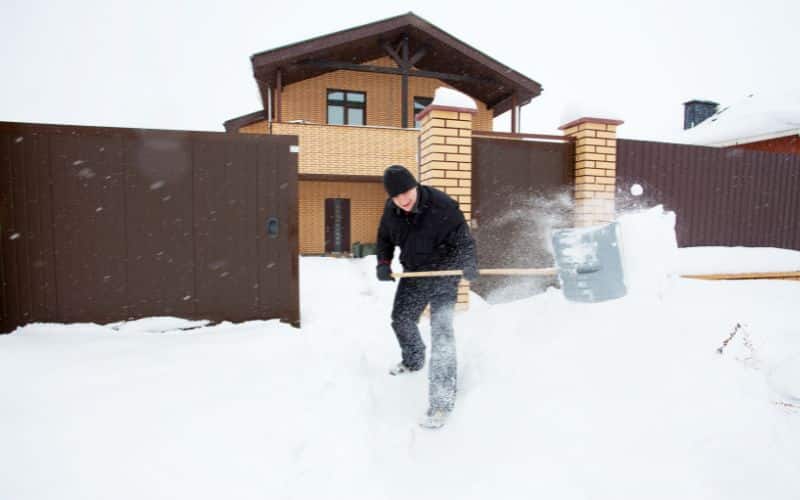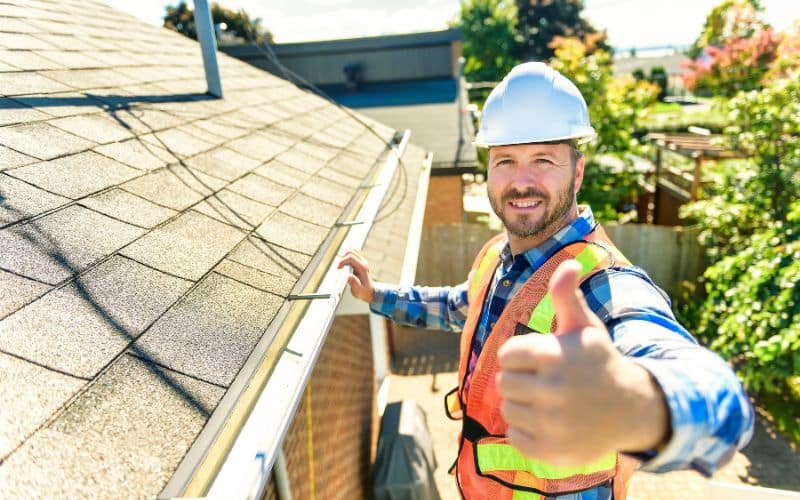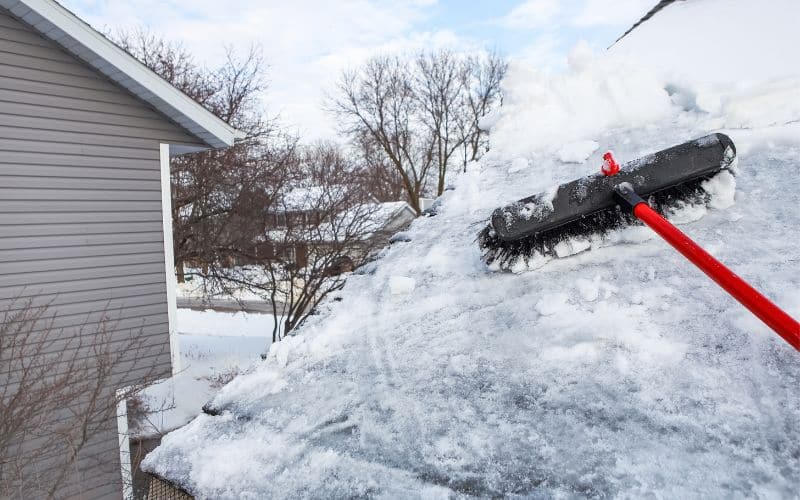
Winter weather can be a beautiful sight, but it’s not always kind to your home. Snow accumulation around your property can lead to a host of problems, including potential flooding. However, with a few preventative measures, you can minimise the impact of snow on your property and keep your home safe and dry.
Products like Quick Dam offer an easy solution to this problem. These sandless sandbags and flood barriers can be placed around your home to absorb and redirect meltwater. It’s a simple, cost-effective way to prevent water from seeping into your home.
Remember, it’s not just about protecting your home from flooding. Clearing snow from your decks, patios, and driveways that slope toward your home is also essential. It’s worth noting that one inch of snow falling evenly on 1 acre of ground can equate to over 10,000 litres of water. With that in mind, it’s crucial to keep snow at least 3 to 5 feet away from your home’s base and ensure your gutters and downspouts are clear for proper drainage.
Understanding the Problem
Winter weather, specifically snow accumulation and ice build-up, can create significant setbacks for your property. By understanding these problems at a granular level, you’ll be well-equipped to prevent damage that might impact the structure and longevity of your home.
The Impact of Snow on Houses
Heavy snow accumulation has the potential to cause immense strain on the structures of your house. Canadian homes are generally equipped to withstand such demanding conditions, but an extra build-up can lead to weight-related damages, especially on your rooftops. It’s critical to take necessary action when the accumulation reaches around 70 cm of snow or two inches of ice.
Melting snow creates abundant water that can find its way into your property if there are any vulnerabilities. It’s estimated that one inch of snow on 1 acre of ground can convert into over 10,000 litres of water.
This water doesn’t simply vanish; it infiltrates the soil, contributing to a natural process known as hydrostatic pressure. This pressure acts against the foundations of your property, testing its limits.
Common Issues Caused by Snow
One primary concern with melting snow is basement flooding. If your house has small cracks around the foundation, window wells or your property grading isn’t up to scratch, melting snow can provide the water flow that seeps into your home’s foundation.
As ice and snow on your rooftops commence melting, the water that forms requires a place to go. If your property’s gutters and downspouts are blocked orfunctioning below par, this water may accumulate around your foundation, leading to potential basement flooding, mold growth, or more severe effects.
Remember, minor cracks in your structure’s foundation need your attention. Although easy to neglect or dismiss, a minor crack can provide the window of opportunity for a major water intrusion when melting snow comes into the equation.
Another serious winter issue is the formation of ice dams near the edge of your rooftops. Occurring due to poor ventilation or insulation, they block the flowing water caused by melting snow, forcing the water to infiltrate your property. After all, it needs a place to go.
Clogged dearways, driveways, and sidewalks due to icy, snow-packed conditions can also lead to notable inconvenience and physical strain. On top of that,
claims resulting from snow and ice-related damage spike during the cold season; a solid indication of the widespread issue at hand.
While everyone anticipates the winter season for fun-filled activities like skiing and snowboarding, it’s equally important to be aware of potential problems caused by snowfall and ice buildup in and around your house. Having firsthand knowledge about the implications will allow you to prepare your property against such calamities, mitigating the risks in the run.

Preparing for Winter
With winter storm warnings up and the likelihood of significant snowfall just around the corner, it’s time to swing into action and get your home winter-ready. In this guide, we offer essential tips on how to prepare your property for impending cold weather. Let’s dive in!
Inspecting and Repairing Roof
Your roof is your first line of defence against snow damage. Get an early start on detecting problems by inspecting your roof before the first snowfall. Deal with any traces of snow accumulation immediately and if you’re uncomfortable doing it yourself, hire a professional.
Use a roof rake (available at your local home and garden retailer) to clear your roof but be sure to cover your gutters first to avoid shovelling snow into them. Look for any heavy branches veering too close to your roofline, and get those trimmed as they might cause damage under the weight of the snow.
Keep an eye out for cracks in your foundation and seal any that you find right away. As the snow melts, look for signs of pooling water and elaborate plans to direct it away from the house. Finally, inspect your attic for any gaps or openings that could allow warm air to escape, and ensure no space exists between the batt insulation strips.
Clearing Gutters and Downspouts
Gutters and downspouts tend to be overlooked but they’re as crucial as your roof in preventing water and snow damage. Ensure these are cleared out of debris in order to facilitate their function of directing roof snowmelt away from your home.
Before the snow starts to fall, verify that your gutters and drain systems are free of leaves, dirt, and other clutter that can cause obstruction. If there’s a chance that the paths for water are leading too close to your dwelling, you may need to consider installing additional drains. If snow or ice does clog your downspouts, be sure to clear the area around them promptly.
Applying Roof Coatings
Applying a defensive coating on your roof is another preventative measure you can take to protect your home during the winter months. Roof coatings form a protective barrier against water seepage and help manage and direct the flow of melting snow.
Whether a high-performance elastomeric coating or a silicone-based one, a roof coating application can help extend the life of your roof and reduce cooling costs. While it is possible to apply these coatings yourself, it’s recommended to hire a professional to ensure the job is done correctly.
Keeping Snow Away from the House
In the tight grip of winter’s chill, a blanket of snow may look picturesque on your home’s exterior. Yet, it can surreptitiously invite a host of issues. From structural strains, unanticipated flooding, to dampness creeping into your comfortable abode, this pristine white menace can be a package of trouble! But don’t fret, there are several preventive measures in your power, which can save your home from succumbing to a winter breakdown.
Creating Snow Barriers
Having effective snow barriers in place serves as a vital first line of defence. Innovative solutions, such as sandless sandbags and flood barriers, are assets in this battle against snow. By placing these quick absorbers around the areas you worry most about flooding, they intake the melting snow water while redirecting it away from your home. This process is essentially an exercise in creating a moat around your precious home fortress, which offers protection from uninvited external elements.
Additionally, remember to remove snow from the roof, as it will transform into a significant amount of water when it melts. Be mindful not to damage the roofing material, leave a 2-inch layer of snow to prevent direct tool contact with the roof.
Using Snow Removal Tools
Equip yourself with the right snow removal tools and equipment. It’s an essential arsenal when it comes to caring for your home and its surroundings during winter.
Shovels and brooms are your snow-removal allies aside from your snow barrier system. Shoveling snow at least 3 to 5 feet away from your home’s base is essential for avoiding water leakages into the structure as the snow melts. Also, regularly keep a check on sidewalks, gutters, and downspouts and ensure they are clear from snow; they are crucial for aiding the snowmelt to drain properly.
If shovels seem cumbersome or perhaps, you’re caught in an unsuspecting storm, plastic tarps work wonders too. Simply lay these over exposed walkways and conveniently pull them off when the snowfall stops. Myth debunked, snow removal doesn’t necessarily always have to be manual!
Installing Heat Cables
Savvy to the snow troubles? Go a step further by incorporating preventive infrastructure. Heat cables installed along your roof’s edges can dramatically reduce the possibility of icy dams forming. These, combined with a well-insulated attic, prevent the escape of warm air, thus reducing the risk of snow melting off and forming ice dams.

Winter Maintenance Practices
Winter can be harsh, but with good maintenance practices, your home can withstand the brunt of it. Focusing on regular snow removal, monitoring your roof for ice dams and managing snow buildup on your roof are some of the ways to keep your property safe and prevent damage.
Regular Snow Removal
Snow removal is crucial for preventing excessive strain on structures and the risk of water infiltration in your home. Don’t wait until the snow stops falling to start clearing it away. Instead, set a light shovelling routine every one to two hours depending on the duration of the snowfall. Consider spreading a bit of sand or cat litter on your work area; its rough texture improves traction, reducing the chance of slips and falls.
Kitty litter and sand might not be the usual snow gear, but they’re perfect for a pinch.
Also, be aware of potential hazards like temporary carports which aren’t designed to support heavy snow and ice buildup. Regularly clearing these structures will prevent collapse. And remember – work from the outside in when clearing snow.
Monitoring Roof for Ice Dams
Ice dams can cause significant issues if they’re allowed to form along the edges of your roof. Regular checks can help prevent this. If you find ice dams, it’s advised to hire professionals with the right tools and a good handle on safety procedures.
Your job doesn’t end here. Inspect your attic for any openings that could let warm air escape from your home. This escaping warm air can cause the snow on your roof to melt, refreeze, and form ice dams, so ensure any openings are adequately sealed.
Icicles hanging from your eaves, pretty as they may be, can also spell trouble. If you spot these chilly decorations, you might be dealing with ice dams too.
Managing Snow Buildup on Roof
A crucial part of winter home maintenance involves dealing with snow buildup on your roof. Most roofs can handle around 20 pounds of snow per square foot but bear in mind that snow can compact beyond this level and risk your roof collapsing.
An accumulation of snow and ice can damage your roofing and even take the form of leaks and floods inside your home. Hence, it’s better to clear off flat and low-slope roofs before temperatures rise. A regular roof rake or shovel can be mighty handy in such situations.
Remember, when clearing snow, make sure you leave a 2-inch layer to prevent any accidental damage to the roof shingles. Following these guidelines will ensure that your roof remains damage-free and ready to shield you from winter’s worst.
But it’s a difficult job to do alone or if you’ve been neglecting it throughout the season. Look out for professional snow removal services that will do the job safely and effectively.
Conclusion
You’ve now got the lowdown on how to protect your home from the harsh winter weather. Remember, it’s not just about clearing the snow away, but also about preventative maintenance. Regular inspections and necessary repairs to your roof, gutters, and downspouts are key. Don’t forget to apply roof coatings for an extra layer of protection.
It’s also important to keep an eye on your roof for ice dams. If you spot any, don’t hesitate to call in the professionals. They’re trained to deal with these icy intruders safely and effectively.
Regular snow removal is crucial to prevent strain on your home’s structures and avoid water infiltration. It’s especially important to clear flat and low-slope roofs before temperatures rise.
Lastly, don’t shy away from hiring professional snow removal services. They’re not only safe and effective but can also save you a lot of time and effort.
Protecting your home from snow doesn’t have to be a daunting task. With the right strategies and help from professionals, you can keep your home safe and sound all winter long.








